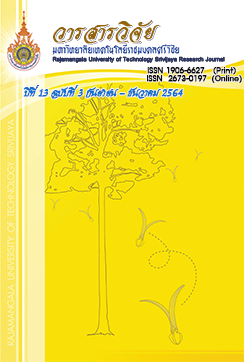สมบัติทางด้านซีเมนต์ของซีเมนต์เพสต์ผสมผงลามิเนต จากขยะอิเล็กทรอนิกส์
คำสำคัญ:
ขยะอิเล็กทรอนิกส์บด, ผงลามิเนต, สมบัติทางด้านซีเมนต์, กำลังอัด, การนำความร้อนบทคัดย่อ
งานวิจัยนี้มีวัตถุประสงค์เพื่อศึกษาสมบัติทางด้านซีเมนต์ของซีเมนต์เพสต์ผสมขยะอิเล็กทรอนิกส์ (Electronic Waste) ในรูปของผงลามิเนต ซึ่งเป็นขยะที่ไม่สามารถย่อยสลายได้กลับมาใช้ประโยชน์ เป็นวัสดุซีเมนต์ ปูนซีเมนต์ปอร์ตแลนด์ประเภทที่ 1 ถูกแทนที่ด้วยผงลามิเนตที่อัตราส่วนร้อยละ 0, 10, 20, 30, 40 และ 50 โดยน้ำหนัก ทำการศึกษาคุณสมบัติทางเคมีและกายภาพของวัสดุ สมบัติของซีเมนต์เพสต์ในสภาวะยังไม่แข็งตัวและแข็งตัวแล้ว ผลการทดสอบพบว่า ผงลามิเนตมีซิลิคอนไดออกไซด์ (SiO2) เป็นองค์ประกอบหลักถึงร้อยละ 35.95 ความต้องการน้ำและระยะเวลาก่อตัวของซีเมนต์เพสต์ผสมผงลามิเนตมีค่าเพิ่มขึ้นเมื่ออัตราส่วนการแทนที่เพิ่มขึ้น ในขณะที่ความหนาแน่นและกำลังอัดลดลงเมื่ออัตราการแทนที่เพิ่มขึ้น อีกทั้งผลของการผสมผงลามิเนตมีนัยนะสำคัญในการลดความหนาแน่นแบบแห้งและค่าสัมประสิทธิ์การนำความร้อนของซีเมนต์เพสต์
เอกสารอ้างอิง
ASTM. 2018a. ASTM C150. Standard Specification for Portland Cement. Annual Book of ASTM Standard. American Society for Testing and Materials, West Conshohocken, Philadelphia, USA.
ASTM. 2018b. ASTM C187. Standard Test Method for Amount of Water Required for Normal Consistency of Hydraulic Cement Paste. Annual Book of ASTM Standard. American Society for Testing and Materials, West Conshohocken, Philadelphia, USA.
ASTM. 2018c. ASTM C191. Standard Test Methods for Time of Setting of Hydraulic Cement by Vicat Needle. Annual Book of ASTM Standard. American Society for Testing and Materials, West Conshohocken, Philadelphia, USA.
ASTM. 2018d. ASTM C109. Standard Test Method for Compressive Strength of Hydraulic Cement Mortars (Using 2-in. or [50 mm] Cube Specimens). Annual Book of ASTM Standard. American Society for Testing and Materials, West Conshohocken, Philadelphia, USA.
Bala Subramanian, B., Gopala Krishna, Gvt. and Saraswathy, V. 2018. Review of Literature on Electronic Waste Materials Used in Concrete. International Journal of Latest Engineering and Management Research (IJLEMR) 3(2): 31-35.
Ban, B.C., Song, J.Y., Lim, J.Y., Wang, S.K., An, K.G. and Kim, D.S. 2005. Studies on the reuse of waste printed circuit board as an additive for cement mortar. Journal of environmental science and health. Part A, Toxic/hazardous substances & environmental engineering 40(3): 645-56.
BS. 2001. BS EN 12667. Thermal performance of building materials and products. Determination of thermal resistance by means of guarded hot plate and heat flow meter methods. Products of high and medium thermal resistance. British Standards Institution, London, United Kingdom.
E-Waste Green Network. 2020. Increase amount of E-Waste. Available Source: https://ewastethailand.com/en/content-en/the-amount-of-electronic-waste-is-increasing-all-over-the-world-en/, March 25, 2020.
Isranews Agency. 2018. Department of industrial works reveals e-waste found 'mobile - circuit board - computer' imported the highest amount. Available Source: https://www.isranews.org/thaireform/thaireform-news/664
-ewaste-66441.html, March 25, 2020. (in Thai).
Marques, A.C., Marrero, J.C., and Malfatti, C.F. 2013. A review of the recycling of non-metallic fractions of printed circuit boards. SpringerPlus 2(521): 1-11.
Nagajothi, P.G. and Felixkala, T. 2015. A Study on Reusing Waste Printed Circuit Board Powders and Chips in Cement Mixes International. Journal of Earth Sciences and Engineering 8(2): 460-464.
Nakornjan, C. and Sopa, S. 2018. Problem of Enforcement Law of Environment Relating to E-Waste Management in Thailand. Journal of Pacific Institute of Management Science 4(1): 242-259.
Office of Natural Resources and Environmental Policy and Planning. 2017. Environmental Quality Situation Report 2017. Available Source: https://www.onep.go.th/ebook/soe/soereport2017.pdf, March 25, 2020. (in Thai).
Patidar, S., Patidar, V., Raj, S., Nema, S. and Nim, A. 2017. E Waste as a Replacement of Aggregate in M 25 Concrete. International Journal for Research & Development in Technology 7(5): 384-387.
Pollution Control Department. 2016. Hazardous Waste Management Guideline (WEEE). Available Source: http://pcd.go.th/info_serv/haz_battery.htm, March 25, 2020. (in Thai).
Premur, V., Vučinić, A.A., Vujević, D. and Bedeković, G. 2016. The Possibility for Environmental Friendly Recycling of Printed Circuit Boards. Journal of Sustainable Development of Energy, Water and Environment Systems 4(1): 14-22.
Senthil Kumar, K. and Baskar, K. 2015. Recycling of E-plastic waste as a construction material in developing countries. Journal of Material Cycles and Waste Management 17: 718-724.
ดาวน์โหลด
เผยแพร่แล้ว
รูปแบบการอ้างอิง
ฉบับ
ประเภทบทความ
สัญญาอนุญาต
เนื้อหาและข้อมูลในบทความที่ลงตีพิมพ์ในวารสารวิจัยมหาวิทยาลัยเทคโนโลยีราชมงคลศรีวิชัย ถือเป็นข้อคิดเห็นและความรับผิดชอบของผู้เขียนบทความโดยตรง ซึ่งกองบรรณาธิการวารสารไม่จำเป็น ต้องเห็นด้วย หรือร่วมรับผิดชอบใดๆ
บทความ ข้อมูล เนื้อหา รูปภาพฯลฯ ที่ได้รับการตีพิมพ์ในวารสารวิจัย มหาวิทยาลัยเทคโนโลยีราชมงคลศรีวิชัย ถือเป็นลิขสิทธ์ของวารสารวิจัย มหาวิทยาลัยเทคโนโลยีราชมงคลศรีวิชัย หากบุคคลหรือหน่วยงานใดต้องการนำทั้งหมดหรือส่วนหนึ่งส่วนใดไปเผยแพร่ต่อหรือเพื่อการกระทำการใดๆจะต้องได้รับอนุญาตเป็นลายลักษ์อักษรจากวารสาร มหาวิทยาลัยเทคโนโลยีราชมงคลศรีวิชัยก่อนเท่านั้น







